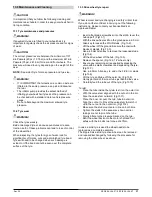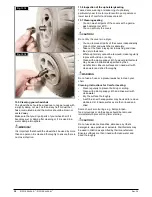
ZIPPIE SALSA R
2
/ ZIPPIE SALSA M
2
49
Rev.2.0
10.0 Speciality Controls
10.1 Proximity head array
WARNINGS
• The sensors used in this product will operate if moisture
of any substance that is electrically conductive is
present in sufficient quantities.
• Electro magnetic interference from electrical power
lines and certain types of phones will cause the sensors
to activate.
• These sensors are capacitive in nature and any material
that is conductive will activate them. These sensors
are electronic sensors and generate an electronic field
which can be affected by liquids and radio frequency
interference.
• If the user is caught in the rain or some type of liquid is
spilled on the sensor pad, the chair has a great potential
to act erratically. Try to activate the stop sensor or shut
the chair down if possible.
• Avoid use under high power lines and around cell
phones which will interfere with the electronic field
generated by the sensor.
• A warning must be conveyed to the wheelchair operator
that the chair could come to a sudden stop or act in
an erratic manner due to liquids or radio frequency
interference (RFI).
• Most electronic equipment is influenced by (RFI).
Caution should be exercised with regard to the use of
portable communication equipment in the area around
where the sensors are located in the head array. If
RFI causes erratic behaviour, shut the wheelchair
off immediately. Leave off while transmission is in
progress.
10.2 Driving with the head array (Fig 10.1)
The head array uses 3 zero touch sensors for driving, one
in each head pad.
The sensor in the centre of the headpiece controls forward
and reverse.
Sensors in the right and left headpieces are for right and left
directional motion respectively.
The fourth switch is the mode switch and it toggles the
head array between forward and reverse and between
driving the wheelchair and operating any ancillary devices
(such as powered seating or augmentative communications
systems).
Switching modes
A variety of mode switches are available. These can be
divided into three types: internal, hardware mounted and
external.
• Internal: mode in left pad or right pad
• Hardware mounted: beam switch
• External: fibre optic, button or mode jack 2. All mode
switches perform the same tasks.
• Single click of the mode switch will toggle between
forward and reverse.
• A double click of the mode switch will change the
operating mode of the system. e.g. standby to drive
to actuator etc.
For further details refer to the user manual supplied with
your module or contact your Sunrise Medical authorised
dealer.
10.3 Proportional head control
Operation of the head control (Fig 10.2)
1. The drive is based on displacement of the headrest.
A small amount of pressure must be exerted on the
headrest to generate results.
2. Neutral position is when the headrest is not displaced.
3. When the headrest moves right or left, the chair will
move in the respective direction.
4. For forward or reverse the headrest needs to be
displaced in a backwards direction. Use of the mode
switch selects the direction of movement. This will be
displayed on the enhanced display module.
5. The greater the displacement of the headrest from the
neutral position the faster the chair will go.
For further details refer to the user manual supplied with
your module or contact your Sunrise Medical authorised
dealer.
Head Controls
Please refer to the R-net Owner’s Manual for
details of R-net hand control functions
Fig. 10.1
Fig. 10.2
















































